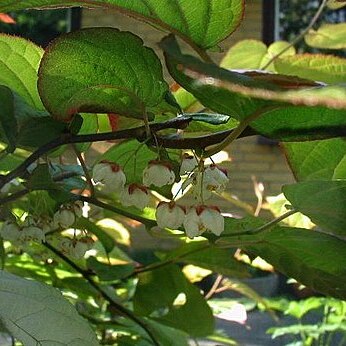Climbing shrubs to woody climbers, dioecious or polygamous, glabrous or hairy; indumentum of stellate or simple hairs; branches with solid or often lamellate (segmented) pith, usually with longitudinally linear lenticels. Leaves often long-petiolate; stipules minute, obsolete or absent; lamina membranous, papery or leathery; margin serrate or dentate, rarely entire; venation penniveined, the veinlets reticulate. Inflorescences cymose, axillary, often pseudo-umbellate, few-or many-flowered, rarely flowers solitary; bracts minute. Flowers bisexual, white, pink, reddish, yellow or green. Sepals (2–) 5 (6), distinct or connate at base, imbricate, rarely valvate, persistent or not. Petals (4) 5 or rarely more, imbricate. Stamens numerous, in functionally female flowers often with shorter filaments and smaller sterile anthers; filaments slender; anthers yellow, brown, purple or black, versatile, attached at middle, 2-celled, dehiscing lengthwise, usually divaricate at base. Disc absent. Ovary ovoid, cylindrical or bottle-shaped, glabrous or hairy, many-loculed; ovules numerous per locule; styles as many as carpels (15–30), usually reflexed, persistent, radiating, in functionally female flower elongating after anthesis; rudimentary ovary in functionally male flower very small, with minute styles. Fruit a berry, globose, ovoid or obloid, sometimes spotted with lenticels, glabrous or hairy. Seeds numerous, oblong, small, embedded in pulp; testa cartilaginous, reticulate-pitted; albumen copious and abundant; embryo comparatively large, cylindrical, straight, at centre of albumen; cotyledons short.
Trailing shrubs or lianas without special organs for climbing, branches rarely flexuose; stem with wide vessels, raphides in the flowering parts: bark often with short linear lengthwise lenticels. Growth in flushes from terminal and axillary buds. Indumentum of stellate or simple hairs. Stipules minute, obsolete, or absent. Leaves simple, scattered, petiolate, serrate or callous-dentate, penninervous, midrib sulcate, veins in cross-bars, veinlets reticulate. Inflorescences lateral, often on a common peduncle forked at the apex, cymose, often pseudo-umbellate; bracts 2, at the apex of the peduncle. Flowers mostly white, dioecious (or polygamous), 5(-4)-merous. Sepals distinctly imbricate (rarely valvate), free or subconnate at the base, persistent. Stamens (10-)∞, in ♀ flowers with short filaments and small sterile anthers; filaments thin, anthers versatile, base divaricate, attached in the middle, reflexed in bud, dehiscing lengthwise. Disc absent. Ovary free, superior, tomentose (or glabrous), (5-) ∞-celled; ovules attached on the central axis. Styles free, (5-)∞, persistent, elongating after flowering in ♀, ± clavate, spreading, in ♂ ovary small, with minute styles. Berry glabrous (or hairy), often spotted by lenticels, oblong. Seeds ∞, small, biconvex, oblong, immersed in pulp; testa cartilagineous, reticulate-pitted, dark when dry; albumen copious; integuments 1; embryo cylindrical straight, cotyledons short.
Dioecious or gynodioecious, deciduous lianes, with twining stems. Pith solid or lamellate. Lvs usually serrate, rarely entire. Fls usually in axillary cymes, sometimes solitary, cup-shaped. Petals convolute, delicate, usually white. Stamens numerous. Ovary with numerous locules. Styles numerous. Fr. a fleshy berry. Seeds numerous, embedded in pulp.

